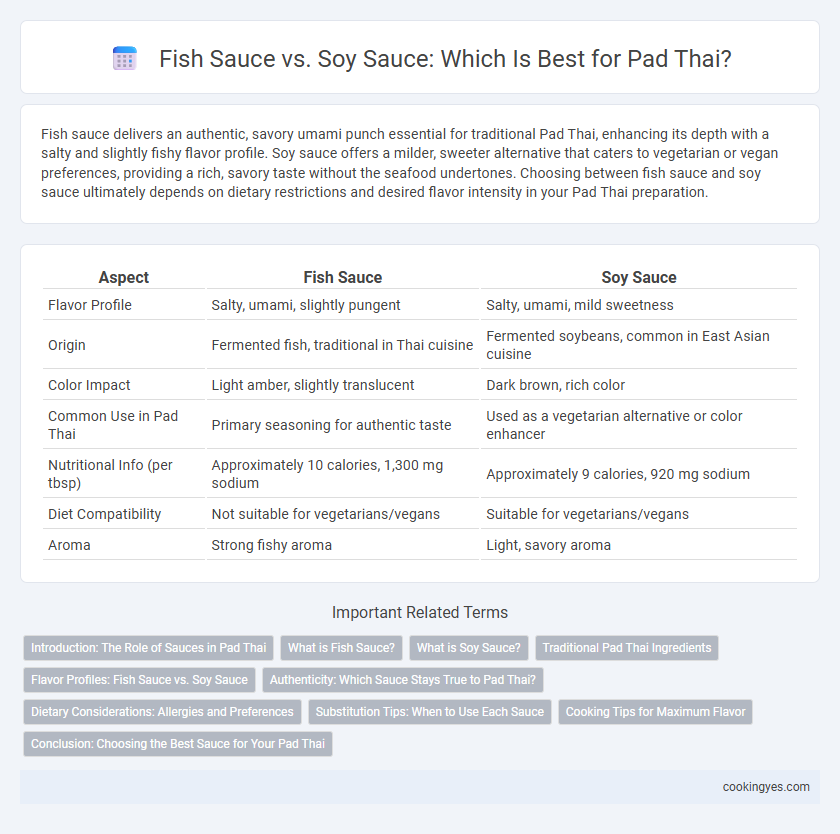Fish sauce delivers an authentic, savory umami punch essential for traditional Pad Thai, enhancing its depth with a salty and slightly fishy flavor profile. Soy sauce offers a milder, sweeter alternative that caters to vegetarian or vegan preferences, providing a rich, savory taste without the seafood undertones. Choosing between fish sauce and soy sauce ultimately depends on dietary restrictions and desired flavor intensity in your Pad Thai preparation.
Table of Comparison
| Aspect | Fish Sauce | Soy Sauce |
|---|---|---|
| Flavor Profile | Salty, umami, slightly pungent | Salty, umami, mild sweetness |
| Origin | Fermented fish, traditional in Thai cuisine | Fermented soybeans, common in East Asian cuisine |
| Color Impact | Light amber, slightly translucent | Dark brown, rich color |
| Common Use in Pad Thai | Primary seasoning for authentic taste | Used as a vegetarian alternative or color enhancer |
| Nutritional Info (per tbsp) | Approximately 10 calories, 1,300 mg sodium | Approximately 9 calories, 920 mg sodium |
| Diet Compatibility | Not suitable for vegetarians/vegans | Suitable for vegetarians/vegans |
| Aroma | Strong fishy aroma | Light, savory aroma |
Introduction: The Role of Sauces in Pad Thai
Fish sauce and soy sauce are essential components in achieving the authentic taste of Pad Thai, each contributing distinct layers of flavor. Fish sauce delivers a salty, umami depth derived from fermented fish, enhancing the dish's complexity and traditional Thai profile. Soy sauce offers a milder, slightly sweet and savory taste that balances the intense flavors, especially in vegetarian or less pungent versions of Pad Thai.
What is Fish Sauce?
Fish sauce is a fermented condiment made from anchovies and salt, essential for authentic Pad Thai to provide a distinct umami flavor and subtle saltiness. Unlike soy sauce, which is plant-based and has a milder taste, fish sauce delivers a deeper, oceanic aroma that enhances the dish's complexity and balances its sweetness and tanginess. This savory ingredient is a staple in Thai cuisine, offering a unique flavor profile that soy sauce alone cannot replicate.
What is Soy Sauce?
Soy sauce is a fermented condiment made primarily from soybeans, wheat, salt, and water, integral to many Asian cuisines for its umami-rich flavor. In Pad Thai, soy sauce offers a milder, slightly sweet and salty taste compared to the intense pungency of fish sauce, balancing the dish's complex flavor profile. Its dark color also adds a rich hue to the noodles, enhancing the dish's visual appeal while complementing ingredients like tamarind and lime.
Traditional Pad Thai Ingredients
Traditional Pad Thai relies on fish sauce as a fundamental ingredient, delivering its characteristic umami and savory depth that soy sauce cannot replicate. Fish sauce, made from fermented anchovies, enhances the complex balance of sweet, sour, salty, and spicy flavors essential to authentic Pad Thai. Soy sauce, although commonly used in some variations, lacks the distinctive pungency and subtle oceanic notes intrinsic to classic Thai cuisine.
Flavor Profiles: Fish Sauce vs. Soy Sauce
Fish sauce imparts a strong umami and salty flavor with a distinct, slightly fermented aroma, essential for authentic Pad Thai's savory depth. Soy sauce offers a milder, sweeter, and less pungent taste, lending a subtle umami note without overpowering other ingredients. Combining fish sauce with a touch of soy sauce balances the dish, enhancing complexity while maintaining traditional flavor profiles.
Authenticity: Which Sauce Stays True to Pad Thai?
Fish sauce is the authentic choice for Pad Thai, delivering the signature umami and salty flavor that defines traditional Thai cuisine. Soy sauce, while a common substitute, lacks the depth and complexity of fish sauce, altering the dish's characteristic taste profile. True Pad Thai recipes rely on fish sauce to maintain cultural and culinary authenticity.
Dietary Considerations: Allergies and Preferences
Fish sauce, a staple in traditional Pad Thai, contains anchovies and may trigger allergic reactions in individuals sensitive to shellfish or fish. Soy sauce offers a plant-based alternative suitable for vegetarians and those avoiding seafood allergens but often contains gluten, which may be a concern for people with celiac disease or gluten intolerance. Choosing between fish sauce and soy sauce depends on dietary restrictions, allergy risks, and personal taste preferences to maintain authentic flavor while accommodating health needs.
Substitution Tips: When to Use Each Sauce
Fish sauce provides authentic umami and depth of flavor essential for traditional Pad Thai, ideal when aiming for genuine Thai taste. Soy sauce is a suitable substitute for vegetarians or those avoiding fish sauce, offering a milder, saltier profile that complements the dish without overpowering it. Use fish sauce when you want rich, briny complexity and soy sauce for a plant-based alternative that maintains savory balance.
Cooking Tips for Maximum Flavor
Fish sauce delivers authentic umami depth essential to traditional Pad Thai, while soy sauce offers a milder, slightly sweet alternative suitable for vegetarians. Balancing the two can enhance complexity without overpowering the dish, using fish sauce sparingly to avoid saltiness. For maximum flavor, add fish sauce early in cooking to allow its aromas to develop, and incorporate soy sauce towards the end for subtle sweetness and color.
Conclusion: Choosing the Best Sauce for Your Pad Thai
Fish sauce delivers the authentic umami and savory depth essential to traditional Pad Thai, intensifying its characteristic bold flavors. Soy sauce offers a milder, slightly sweet alternative suited for vegetarian versions, providing a subtler seasoning without overpowering the dish. For the best Pad Thai, select fish sauce to achieve genuine taste unless dietary preferences call for soy sauce as a flavorful substitute.
Fish sauce vs soy sauce for Pad Thai Infographic

 cookingyes.com
cookingyes.com